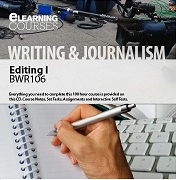 Dreaming of a career in editing or publishing?
Dreaming of a career in editing or publishing?
Don't know where to start?
This course will provide you with practical experience producing an online publication under the guidance of experienced tutors.
Gain the "know-how" you need to get started.
Through this experience you will:
- develop your ability to edit both text and illustrations for articles
- learn how to prepare layout for articles
- learn to edit according to specification
- gain experience that you can use to build your C.V. to demonstrate experience in publishing
- create a body of work to shows your experience in copy editing for online publications